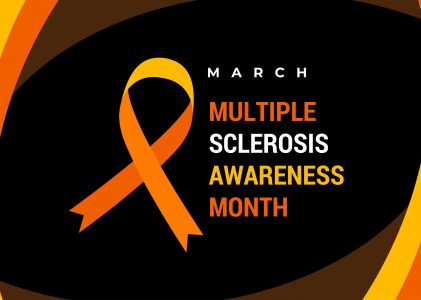 March is known for college basketball madness, but it is also time to break out your orange rubber wristband, orange t-shirt, orange lapel pin or orange ribbon. The color orange represents Multiple Sclerosis awareness. A simple way to spread awareness about this debilitating disease is to wear the color orange throughout this month.
March is known for college basketball madness, but it is also time to break out your orange rubber wristband, orange t-shirt, orange lapel pin or orange ribbon. The color orange represents Multiple Sclerosis awareness. A simple way to spread awareness about this debilitating disease is to wear the color orange throughout this month.
Multiple sclerosis (MS) causes a variety of symptoms, which for many, can show themselves and then go dormant over time. MS is not contagious, however its causes are not yet completely understood, and doctors continue to search for answers. But there is some good news on the research front.
An estimated one million people live with Multiple Sclerosis in the U.S. Most people with MS are diagnosed between the ages of 20 and 50. The disease affects women three times more than men. In 2015, about 2.3 million people across the globe had MS with rates varying widely in between regions and populations. In 2015 about 19,000 people died from MS, up from 12,000 in 1990.
MS was first described in 1868 by French neurologist Jean-Martin Charcot. The name refers to the numerous scars that develop on the brain and spine.
MS Diagnosis
MS is often diagnosed in young adults, although any age group can be diagnosed with it. People are many times confused by its name and unique symptoms. Despite the daunting diagnosis, most individuals with MS are able to live a full and productive life.
While symptoms vary from visual changes to numbness, bladder issues, fatigue or depression, many individuals should be relieved to know that these symptoms are often temporary early in the disease course.
What Exactly is MS?
MS manifests itself by damaging the insulating covers of nerve cells in the brain and spine. The damage disrupts parts of the nervous system, and they cannot transmit signals. This leads to physical, mental, and sometimes psychiatric problems. Symptoms can include double vision, blindness, weakness, and trouble with coordination.
The cause is unclear, however the underlying mechanism could be destruction of the immune system or failure of the myelin-producing cells. Myelin is the insulating layer, a sheath that forms around the nerves including those in the spine and brain. Causes could include genetics and environmental factors.
There is no cure for MS. Current treatments look to improve function after an attack and prevent relapses. Medications used to treat MS are now modestly effective. Physical therapy and occupational therapy can help with people’s ability to function.
New Research on Smell and MS
There is hope. In 2019 the U.S. Food and Drug Administration approved Siponimod, a tablet taken orally that is an immune modulating therapy that helps reduce relapses and the progression of MS.
In a study conducted by the Medical University of Vienna in 2022 involving 123 people with MS, researchers tested whether smell was linked to treatment response. Participants were less likely to experience a relapse when improvements in the ability to smell occurred in the first year of starting an MS treatment. Sensitivity to odors could be an easy way to identify response to treatment.
Smell sensitivity was tested with odor-dispensing devices at the beginning of a disease-modifying treatment, and again at three months and 12 months. The primary goal of the study was to determine whether smell sensitivity improvements were linked to relapses of MS. At each time point, improved smell sensitivity was linked to a reduction in the risk of having a relapse.
Greater Waterbury Imaging Center cares about your health and wellness and asks you to help raise awareness of multiple sclerosis. With early medication and treatment, sufferers can live a fulfilling life. Remember to contact GWIC for all your MR imaging needs.


